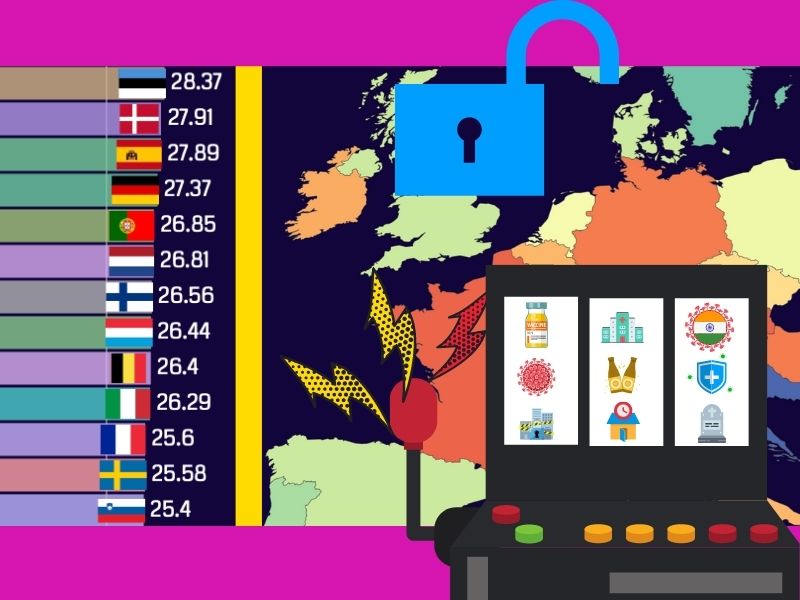
Europe is slowly but surely emerging from the lockdown. Many governments are convinced that thanks to the immunity provided by vaccines, the final stretch of the long-drawn-out corona marathon seems to be underway. Will the last few kilometers prove to be the hardest? A bit more for some than for others.
Portugal, Spain and the United Kingdom were the first to release the general public at the beginning of this month step by step This seems to be catching on: In Switzerland, Belgium, the Czech Republic and Poland, more is allowed since this week than at the beginning of the year. Whereas for the Netherlands, Denmark, Ireland and Italy, more relaxations are on the agenda next week.
Still, not everyone is joining in. Austria, for example, tightened things up a bit more while the German parliament approved a new “emergency brake law” that, among other things, should make it possible to have nightly curfews on a regional level.
Which restrictions are in force this week, and where exactly? That becomes immediately clear with the heatmaps below.
Lockdown index score
Last week’s instalment introduced the lockdown index score. This data has been updated as governmental policy also now plays a prominent role. Collectively, the 22 measures yield a total score of between zero and one hundred. This gives us an indication of how far corona restrictions go per country.
Because curfews, travel restrictions, mandatory working from home and visiting bans are more far-reaching in nature than the rest, they count for double. The Lockdown Index Scorecard below is colored according to this data. Belgium, which among other things removed travel restrictions and where schools have reopened since Monday, fell the most: from 86 to 68 points.
From fewer infections to fewer restrictions
That corona measures lead to a great deal of frustration is common knowledge among the population. Yet they definitely still have a practical use: Reducing infections to prevent the hospital healthcare system from collapsing and people from dying unnecessarily. However, since there is a downward trend in the number of new Covid-19 diagnoses in most countries, it seems logical to introduce responsible easing.
Responsible easing or risk-taking?
Rapid innoculations combined with the very strict lockdown in the first quarter of this year have meant that the viral fire has subsided the most among the British. This is by no means the case across the board. In France, the number of infections is still sky-high, which is why the ‘Easter lockdown’ was recently extended. Whether the Croats will be able to enjoy their freedom for much longer seems highly questionable given the high rate of increase.
Greece and Ireland are playing it safe, while others are taking more risks. Although the Netherlands is introducing similar easing measures as other countries are also doing, the virus pressure here – as it is in Sweden – remains as high as ever. If you compare the lockdown index score with the number of infections per 100,000 inhabitants, it becomes obvious which countries are taking the biggest gamble.
Therefore the fact that the Netherlands announced far-reaching relaxations this week seems odd on the basis of their figures. Nevertheless, the government of Mark Rutte decided against the advice of the Outbreak Management Team (OMT) to allow the ‘step-by-step plan‘ to be implemented after all. The cabinet found this risk acceptable. A very risky gamble, given that even with the current measures in place, hospitals are already close to collapse.
With the relaxations, the Netherlands will end up with a lockdown index score of 34 by next week. On a par with Portugal and Norway who have far fewer infections. Apparently, the expectations for vaccinations are higher here than elsewhere. Or otherwise several weeks of overloaded ICUs and excess mortality rates have a lower priority than opening terraces, stores and experimental events.
The European jab pecking order
After a rough start, European countries seem to be getting better at picking up the pace when it comes to vaccinating their populations. Provided that resistant virus variants do not throw a spanner in the works, the combination of measures and vaccination coverage should bring the numbers back to manageable values in the rest of the continent as well. In the weekly race of nations, the Netherlands has been starting to appear in the upper ranks since last week.
At the bottom, poverty-stricken Albania manages to pass EU slugs Bulgaria and Latvia in the European pecking order. And as of this week, despite their flying start, the British are no longer the frontrunner.
The definite tipping point
How many jabs does it take before the acute threat of the pandemic will be over? This question should be answered in the next two months. That point is proving quite difficult to estimate and is, logically, reached more quickly with few corona infections among the partially or unvaccinated part of the population. To demonstrate this, here are the ten countries with the highest vaccination coverage followed by the number of infections over the past few weeks.

Tough last leg
That turning point was already reached in Israel by the beginning of February. Britain followed about a month later. In most countries, the number of infections is steadily declining or stabilizing.
Uruguay is currently the scene of a remarkable contrast: Nowhere else in the world are there more jabs per hundred upper arms per day, while at the same time it is the fiercest corona hotspot on earth. Evidently, a risk is being taken there – as it is in Chile – with rolling out early relaxations. This furious vaccination rate should also keep this new crisis under control during injury time against the Brazilian variant. Whether this is worth the gamble? We will know that in about a month’s time.
So, all ten inoculation champions passed the 40 jabs per 100 upper arms since this week. Is this the tipping point? Based on this data, most likely. No other country with such a score has seen such an increase. Yet the United States and the United Arab Emirates have long since passed this point without any significant decline. That said, at the same time, there are also relatively few measures in force over there in the States.
The second gamble
Globally, by the way, it is far from the case that the pandemic is under control. In fact, a 24-hour record was broken in India with as many as 300,000 new positive diagnoses.
Particularly in India, alarming records have been broken in recent weeks that no healthcare provider army can withstand. This is caused by a highly contagious double variant that may also be (even more) resistant to vaccines. And as the number of virus infections rises exponentially, so does the likelihood of new variants that could once again change the rules of the game during the most exhausting dragged-out game of our time.
The original virus strain from Wuhan that started the crisis last year is now almost extinct. That this pandemic will eventually become a manageable one is inevitable. But when? That remains guesswork. As long as the virus is not under control in India and Brazil, another pandemic will remain lurking around the corner.
New Delhi airport hosts recurring flights every day to dozens of destinations including Dubai, Chicago, Frankfurt and Schiphol. This not only takes a gamble with the policy in its own country, but the door to the rest of the world is left very much wide open.








